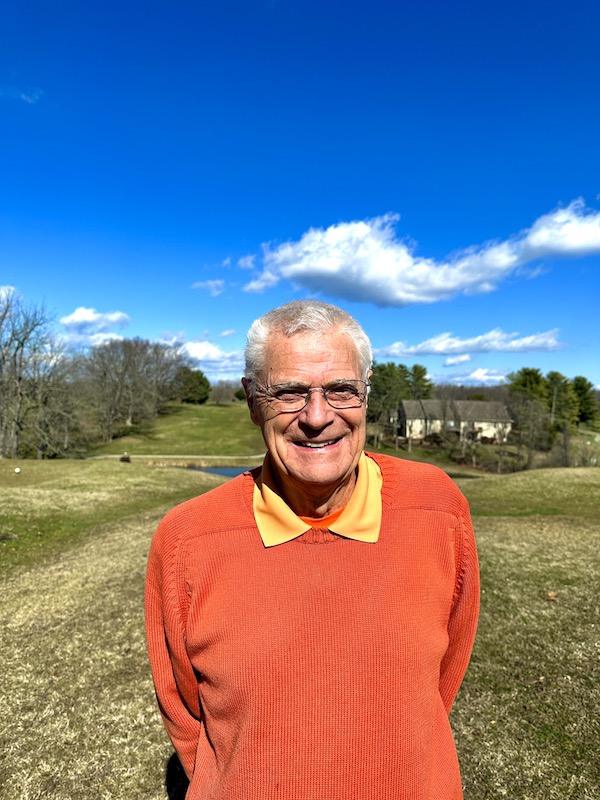The Goat Course

At 83 years old, Bucky can still rip a drive 220 yards out, the bygone days of his youth still lingering in his eyes and hands. It’s Bucky’s remarkable memory and youthful spirit that led me to interview him, especially when I learned that he had played on the long-extinct “Goat Course” above the Homestead Resort.
For two years, I’ve looked for someone who had played on this course, and here, with Bucky beside me, I finally was able to learn what it was really like.
“Back when I was eight or so years old,” Bucky said, “my dad would take me and my friends to the Goat Course. I think it was called the ‘goat’ course because it was a nine-hole course that went up the mountain, jokingly so high up only a goat would traverse it. It climbed the mountain for the first four holes, then a couple more up there as you walked another hundred yards on the mountain. After that, the course came back down.”
Bucky told me that the Goat Course was discontinued somewhere in the late ‘50s or early ‘60s, when the course was transformed to be a downhill ski area for the resort.
“We could play the course for free,” Bucky said. “It was built for people working at the resort and in the town. I think the people who were at the hotel came to play golf on the main course and preferred a well maintained playing area with caddies. If you played the Goat Course, like we did, you had to walk and carry your own clubs up on the mountain ridge.”
At this point in our conversation, Bucky, retrieving memories from 70 years ago, began to trace the air between us with his finger, drawing the entirety of the Goat Course.
“I only played the last eight holes, never the first one,” he said. “Hole number one was right alongside where Homestead’s 17th hole was, so my dad drove us up the maintenance road and started at the second hole instead. We parked there and would start on hole number two for convenience, every time.
“I don’t remember crowds on the Goat Course. The other reason we went up there was to collect golf balls. We would turn them in, and make ten cents a ball. If you found three balls, you could afford a movie ticket back then.”
The Goat Course was rugged: oftentimes with waist-high grass in the rough, steep climbs, no caddies, and no golf carts.
“The second hole was a par-3,” Bucky said. “Think of a drinking glass. You’re teeing off at the bottom of the glass, and you’re hitting up to the top of the glass. I remember one time I teed off and hit straight, and the ball went right into the side of the hill. You had to add height to that hit.
“One par-4 on the course had a tee box that required you to hit 100 yards past high grass before the fairway. However, I learned if I did lose my ball in that grass, it was alright,” he said, grinning. “I may lose one, but I could find four more in there.”
As Bucky explained the different holes, I sensed he was tapping into fond memories, a childhood golf adventure few are blessed to experience in their formative years. Once Bucky became a high schooler, he played baseball, football, and basketball. He worked as a caddy on a six-hole golf course (something I didn’t know existed).
“I got paid big time,” he told me, “one dollar per 18 holes. That was a lot back then. If I was lucky, there was one guy on Saturdays who would give me a quarter for a tip. I also helped set pins on the bowling alley too, and I’d get ten cents a line, three dollars, plus tips.
“Looking back on it, I don’t know if being a caddy made me a better golfer. I definitely learned some swear words, though, and how to throw a golf club when you’re mad.”
Bucky grew up in Covington, VA, and attended Lynchwood College. He then earned a Master’s Degree in psychology and immediately started teaching at a community college and other small colleges.
“I taught psychology at a college, and they wanted to start a soccer program, back in the ‘70s,” he said. “They found out I had played soccer back in my college days, and they threw a team together, with me as the head coach. None of my players had touched a soccer ball before then. We were pretty bad, ending that first season 0-15.
“The next year, I recruited six guys from a high school in New Jersey, and over the next couple years, our team was in the top eight in the country.”
We spoke about other courses in the Shenandoah Valley that have shut down over the years, like Needle’s Eye and Blue Ridge Golf Course. Bucky’s impeccable memory drew out details I myself had forgotten or had never known, like how Needle’s Eye had been run by three brothers who received course membership fees by newcomers knocking on their homes’ screen doors.
As our conversation came to a close, I think I saw Bucky for who he really is: a walking, humble, humorous book of golf course legends no one else can remember, a reservoir of pars and bogeys that create a mural of a life well-lived.
If I ever do find myself on the ski slopes above the Homestead, I’ll take a minute to remember Bucky and his father and their time spent on the “goat” course.
Jefferson Burgess
Editor
Jefferson holds a degree in psychology from Westminster College (SLC, UT). Career experience includes working in design, marketing and sales.
Photography, design, music, food, golf, the outdoors, running, story telling are all things he enjoys.






